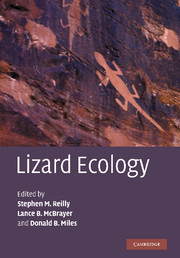Book contents
- Frontmatter
- Contents
- List of contributors
- Preface
- Historical introduction: on widely foraging for Kalahari lizards
- I Organismal patterns of variation with foraging mode
- 1 Movement patterns in lizards: measurement, modality, and behavioral correlates
- 2 Morphology, performance, and foraging mode
- 3 Physiological correlates of lizard foraging mode
- 4 Lizard energetics and the sit-and-wait vs. wide-foraging paradigm
- 5 Feeding ecology in the natural world
- 6 Why is intraspecific niche partitioning more common in snakes than in lizards?
- 7 Herbivory and foraging mode in lizards
- 8 Lizard chemical senses, chemosensory behavior, and foraging mode
- 9 Patterns of head shape variation in lizards: morphological correlates of foraging mode
- 10 Prey capture and prey processing behavior and the evolution of lingual and sensory characteristics: divergences and convergences in lizard feeding biology
- 11 The meaning and consequences of foraging mode in snakes
- II Environmental influences on foraging mode
- Index
- References
1 - Movement patterns in lizards: measurement, modality, and behavioral correlates
Published online by Cambridge University Press: 04 August 2010
- Frontmatter
- Contents
- List of contributors
- Preface
- Historical introduction: on widely foraging for Kalahari lizards
- I Organismal patterns of variation with foraging mode
- 1 Movement patterns in lizards: measurement, modality, and behavioral correlates
- 2 Morphology, performance, and foraging mode
- 3 Physiological correlates of lizard foraging mode
- 4 Lizard energetics and the sit-and-wait vs. wide-foraging paradigm
- 5 Feeding ecology in the natural world
- 6 Why is intraspecific niche partitioning more common in snakes than in lizards?
- 7 Herbivory and foraging mode in lizards
- 8 Lizard chemical senses, chemosensory behavior, and foraging mode
- 9 Patterns of head shape variation in lizards: morphological correlates of foraging mode
- 10 Prey capture and prey processing behavior and the evolution of lingual and sensory characteristics: divergences and convergences in lizard feeding biology
- 11 The meaning and consequences of foraging mode in snakes
- II Environmental influences on foraging mode
- Index
- References
Summary
From the least to the greatest in the zoological progression, the stomach sways the world.
(Fabre, 1913)Introduction
To reproduce successfully, an organism must survive, attain suitable size, attract a mate, and produce viable offspring. All of these activities require that the individual obtain considerable amounts of energy. Foraging success can thus strongly impact reproductive success (Travers and Sih, 1991; Bernardo, 1994; Nilsson, 1994). Reproductive success is the fabric upon which natural selection works (Darwin, 1859). Evolutionary biologists and behavioral ecologists, starting with the pioneering work of MacArthur and Pianka (1966) and Emlen (1966), have therefore shown considerable interest in foraging behaviors and their correlates. The resulting literature is voluminous and often contentious: too much so for a single chapter, or even volume, to effectively summarize. In keeping with the theme of this book, I focus on the issue of bimodality in lizard foraging behavior, its phylogenetic background, and its putative correlates.
Before one can discuss patterns, however, methodological issues must be clarified. This chapter is therefore divided into two main sections. The first section focuses on some previously neglected methodological issues related to measurement of foraging behavior. Establishing these is crucial for ensuring data quality in the analyses that follow. The second section then concentrates on testing theoretical predictions of foraging theory, and on some conceptual consequences of what has been learned to date. Because the literature is so extensive, I frequently limit the use of references to representative examples throughout this chapter.
Information
- Type
- Chapter
- Information
- Lizard Ecology , pp. 13 - 48Publisher: Cambridge University PressPrint publication year: 2007
References
Accessibility standard: Unknown
- 26
- Cited by
